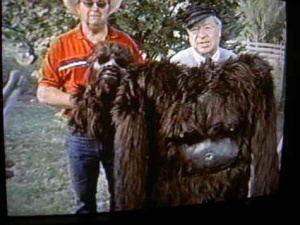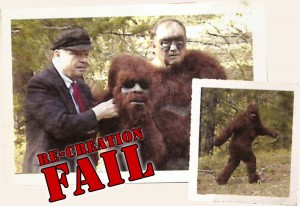(Infamous) Philip Morris
From Loren Coleman
In 2004, Fortean Times published my article, “A Tale of Two Suits,” about the ongoing attempts to discredit the Patterson-Gimlin Bigfoot footage. Seattle Bigfooter Roger Knights examined the inconsistencies in Greg Long’s book by happily dubbing it with a new title, “A Tale of Two Suits.” I used that phrase, in honor of Knights, to capture the silliness of the continuing, groundless debunking claims.
Now it has come to pass that on Sunday, September 24, 2017, one of the two halves of the melodrama about those suits has died. As the Charlottesville Observer stated, “Philip Morris, the one-time circus ringmaster who made gorilla suits in his basement as he built the world’s largest costume distributorship, died late Sunday at his Mooresville home. He was 83.”
Morris fought Alzheimer’s disease in his final months, and passed away peacefully.
“Longtime Charlotteans will remember Morris appearing on WBTV’s ‘Big Bill’s Clubhouse’ and ‘Horror Theater’ on late Friday nights in the 1960s. Younger ones will recognize Dr. Evil (and his son Scott) from the Austin Power movies – a character Morris created for local TV and stage shows in 1959. Scott Morris said his father reached a settlement with film producers over his trademark claim.”
Morris Costumes’ family-run Charlotte company ships 20,000 packages a day, much of it wholesale distribution, will forever be linked to gorilla suits. Morris’ time on the road included working as a ringmaster and costumer for the three-ring Royal Hanneford Circus. A sideshow needed a costume for a girl-to-gorilla act, and a specialty was born.
Morris’ son, repeated to the newspaper, the unproven claim that “in 1967, the company says, a customer named Roger Patterson bought a custom gorilla suit that was used to film the famously grainy footage of a hairy ‘Bigfoot’ striding through the northern California woods.”
After Morris got publicity for his Bigfoot claims, the business grew. The basement operation moved to a small shop, then to a retail store on Monroe Road and a 300,000-square-foot distribution center in University Research Park.
BTW, the reason Roger Knights and I called it a “tale of two suits” is because besides the alleged Morris gorilla suit that was supposedly used for the Bigfoot in the Patterson-Gimlin footage, a sewn horse hide skin was said to be used. That both sources for the costume was in Greg Long’s book without a proofreader catching that caused confusion in the logical of the claims.
Knights’ wrote of this thread, thusly:
Bob Heironimus (BH) Wasn’t Queen Kong (the Bigfoot in the 1967 Patterson film)…
…BH’s initial description of the suit that he wore, supposedly made by Patterson, is very different from the suit he later agreed that he wore, supposedly supplied by costume-maker Philip Morris. BH described the suit he thought Patterson had made as having a zipperless upper torso part that BH donned like putting on a T-shirt…. At Bluff Creek he put on “the top”. Asked about the “bottom portion,” he guessed it was cinched with a drawstring. Morris made a unibody-type union suit that zipped up the back and into which one stepped. It had no torso part or top like Patterson’s (supposed) top-and-trousers affair. This difference between them was one he couldn’t possibly have mistaken or forgotten.
And there were other differences that would have been hard to miss, such as the pronounced difference in hand-feel between heavy, supple, rubbery horsehide and the light, mesh-fabric-backed Dynel in Morris’s. There might be an innocent explanation for BH’s changing his story to accommodate Long’s Morris-Suit theory–but it’s hard to think of one.
Plus… BH was not measured for a custom-fitted suit. And the Morris’s gorilla suit, like all off-the-peg ape-suits, would fit a wearer loosely, even if it had been custom-tailored to the wearer. (E.g., in the movie Harry and the Hendersons, “Harry” has trouser-legs: a pair of uniformly tapering tubes.) Queen Kong, OTOH, has a well-defined body: a butt crack (in the last frames), bulging thunder thighs, mobile kneecap, shapely calf, visible tendons and hamstrings, shoulder blades, realistic biceps, quivering flesh, non-uniform hair color and length, etc., all features missing from Hollywood ape-films.
Philip Morris will go down in history linked to the Patterson-Gimlin film’s Bigfoot, although the connection was always weak and hearsay.

